The Battle of Dunkirk - 28th May - 4th June 1940

Despite their fierce resistance the Allies ran the risk of becoming caught in a trap. They could not break through the barricade by land and more than 400,000 men found themselves stranded north of a line from Sedan to Abbeville. Believing that the battle was lost and looking to reinforce there own defences, the British decided to evacuate their troops from the French theatre of operations. Gradually abandoning their positions, the British expeditionary corps withdrew to Dunkirk in order to be evacuated by sea. Held for a few days on the banks of the Channel and thus giving the Allies a welcome break in realising their objective, the German tanks then advanced towards Dunkirk, as the enemy air force subjected the town to heavy aerial bombardment. The evacuation of allied troops: Operation Dynamo Between the 28th May and the 4th June, the French navy took part alongside the British navy in the re-embarkation of troops. Christened operation "Dynamo" by the British, the evacuation was conducted by Admiral Ramsay. All available boats, even private ones, were requisitioned. Under continual aerial attacks, more than 340,000 allied soldiers, including 120,000 French soldiers and several thousand Belgian soldiers, were to be evacuated from Dunkirk before its fall, of which about one third via the beaches. Left isolated, some 40,000 of their comrades were unable to embark and were taken prisoner; they were mostly soldiers from the 68th and 12th infantry divisions and men from the fortified Flanders sector, whose duty had been to slow down the German advance and who, with support from the aircraft of the Royal Air Force and allied navy, had contributed to the success of the operation. The allied soldiers also left all their heavy equipment behind them: about 2,000 canons and 60,000 vehicles, as well as tonnes of ammunition, fuel and supplies. In addition, although the German air force could not prevent the evacuation, allied losses were considerable: some 150 to 200 boats of all kinds and almost as many aircraft. Human losses at sea amounted to 4,000 to 5,000 men. The French evacuated to England would not stay there long. For the most part, they were repatriated to Brest and Cherbourg in the days, or even hours, that followed, in order to resume fighting. In fact, the French Military Command tried to hold back the German troops along the Somme and the Aisne. But the superiority of the latter was overpowering. Despite a few voices of resistance, France requested an armistice, which was signed in Rethondes on the 22nd June 1940. The struggle would now continue from England.
|
1st September 1939 |
Start of the German attack on Poland. |
|
June 1940 September 1939 |
Declaration of war by Great Britain and France on Germany. |
|
21st March 1940 |
Resignation of Édouard Daladier's government and the constitution of that of Paul Reynaud. |
|
10th May 1940 |
Start of the German offensive in the west: invasion of the Netherlands, Belgium and Luxembourg. |
|
13th May 1940 |
German breakthrough at Sedan. |
|
15th May 1940 |
Paul Reynaud informs Winston Churchill that "the battle is lost"; surrender of the Dutch army. |
|
17/18th May 1940 |
Occupation of Brussels, Anvers and Saint-Quentin by the Germans. |
|
18th May 1940 |
Philippe Pétain becomes Minister of State and Vice President of the Council. |
|
19th May 1940 |
Appointment of General Weygand in place of General Gamelin as commander in chief of the French army. |
|
20th May 1940 |
Occupation of Arras, Amiens and Abbeville by the Germans. |
|
25th May 1940 |
Fall of Boulogne. |
|
26th May 1940 |
Start of the advance of German tanks on Dunkirk; fall of Calais. |
|
27th May 1940 |
Bombardment by the German air force of the entrenched camp at Dunkirk intensifies; fall of Gravelines. |
|
28th May - 4th June 1940 |
Battle of Dunkirk ; operation "Dynamo" to evacuate British and French troops ; surrender of the Belgian army (28th May). |
|
5th - 8th June 1940 |
Breach of the last French lines of defence on the Somme and the Aisne. |
|
10th June 1940 |
Italy joins the war alongside Germany. |
|
14th June 1940 |
Arrival of German troops in Paris, which is declared an open city. |
| 16th June 1940 |
Resignation of Paul Reynaud, Philippe Pétain's cabinet is formed. |
|
17th June 1940 |
French request for an armistice. |
|
22nd June 1940 |
Signature of the Franco-German armistice in Rethondes. |
| 24th June 1940 | Signature of the Franco-Italian armistice in Rome. |
The sinking of the Bourrasque Of all the dramatic events of operation "Dynamo", the sinking of the Bourrasque was one of the most important. In the afternoon of the 29th May, as the vessel had just taken on board French troops from the Quai Félix Faure along with the Bouclier and the Branlebas, it came under fire from the Germans at sea off Belgium. Shortly after, an explosion, probably caused by a mine, shook the vessel, which quickly sank. Of the 700 to 800 men on board the vessel, nearly two thirds perished. The town of Dunkirk and the bombardments The first French city to be heavily bombed and the last to be liberated, Dunkirk was badly damaged during the Second World War. However it is difficult to differentiate between the damage that was caused by the bombardments of 1940 and that which took place at the end of the war. After the war, the city was declared a disaster area, as 90% of it had been destroyed: of the 3,362 buildings in the town before the war, 1,524 were totally destroyed and 805 badly damaged; the port was cluttered up with wrecks and no longer had a quay or a flood gate.
The town became the subject of a new urban plan, designed by the architect Théodore Leveau, which was adopted in 1947. Its reconstruction, financed by the city council and the State and carried out by local companies, began on the 4th September 1949 and was finished in 1963. However, the port was rebuilt in less than two years. Following the work, Dunkirk has generally retained the major roads of its pre-war layout. Although the appearance of the city is relatively consistent, it has totally lost its regional style.
Week-end à Zuydcoote The Battle of Dunkirk, which caused such suffering but which, mostly as a result of brave and sometimes heroic deeds, allowed the evacuation of many soldiers, soon became the inspiration for novelists and film makers. So, in 1949, Robert Merle published the novel "Week-end à Zuydcoote" with which he won the Goncourt Prize. A few years later, in 1964, Henri Verneuil was inspired by this work to make a film for cinema of the same name. These two works, whose success has been unfailing, keep the memory of the siege of Dunkirk alive and prompt you to ask yourself how you would react in the same circumstances.
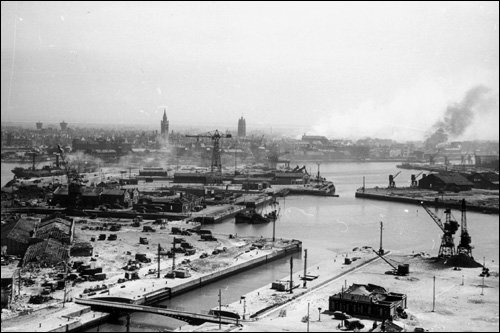
The port of Dunkirk in May 1940. Source: ECPAD France
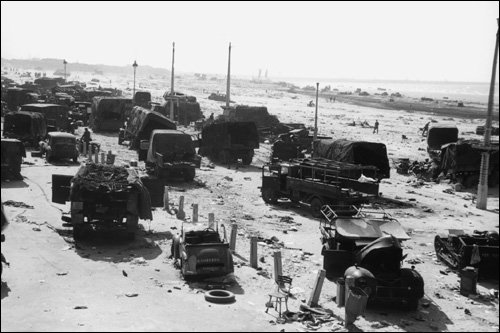
After the evacuation, French and English vehicles scuttled on the beach at Malo-les-Bains.<br>Source: ECPAD France
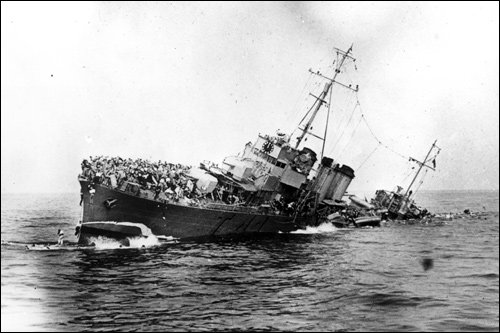
The sinking of the torpedo boat Bourrasque. Source: ECPAD France
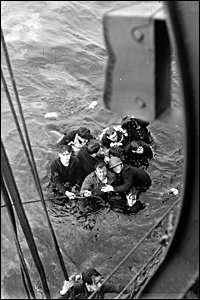
Shipwreck survivors rescued by the Branlebas. Source: ECPAD France
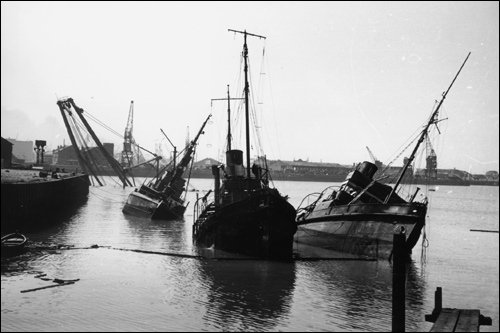
Tugboats from the Rhine sunk in the port of Dunkirk. Source: ECPAD France
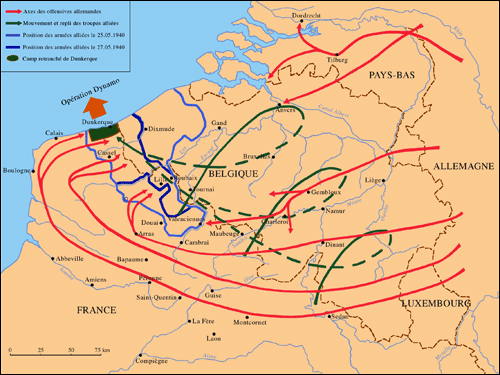
<font color="crimson">Click on the image to open the map in PDF format </font>
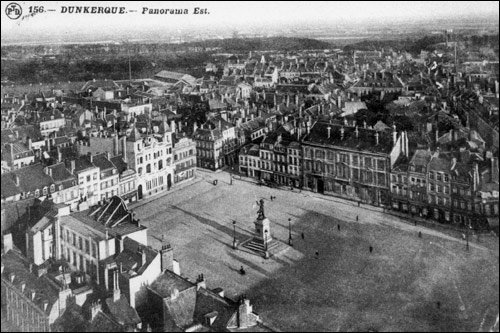
Dunkirk, the Place Jean Bart before the war. Source: Municipal archives of Dunkirk
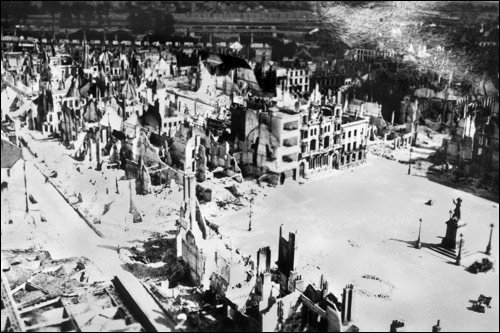
Dunkirk, the Place Jean Bart after the bombardments of May 1940.<br>Source: Municipal archives of Dunkirk
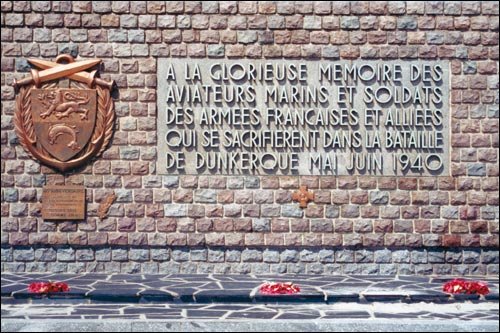
Memorial to the Battle of Dunkirk, on the Digue des Alliés on the beach at Dunkirk.<BR>Source: Municipal archives of Dunkirk

